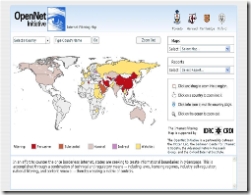With the recent news that the Iranian government has decided to limit ADSL bandwidth above 128 kbps for all ISPs (BoingBoing reported it before Reuters) without giving a reason, it makes sense that this is an opportune time to take stock of state-mandated Internet regulation (including content filtering and surveillance) schemes around the world.
We've done a post before on the OpenNet Initiative (ONI), an organization created through the collective efforts of the various Internet research centers at the University of Toronto, Harvard, Cambridge and Oxford. The main mission of this group is to examine the phenomenon of state control over the Internet (filtering and blocking content, etc.) in various countries. The center has published a number of research papers on their site that are devoted to studying the anatomy and pervasiveness of state-sponsored filtering and information-control initiatives around the world. Case studies concerning content filtering and surveillance are currently available for the following countries:
In addition to case studies and other interesting publications, ONI also provides an interactive map that not only illustrates the state of the Internet in various countries, but also briefs the user on the level of filtering in the country, the way filtering technology is used, the state of the media environment and examples of sites that have been either blocked or filtered.
The filtering levels (from highest to lowest) are described and color coded on the map. The highest level is "Pervasive" which describes all the red areas, followed by "Substantial" (orange), "Nominal"(gray-pink), Indirect (purple) and Watchlist (yellow).
The following levels are assigned to the following countries:
Pervasive
Substantial
Nominal
Indirect
Watchlist
ONI also has a blog, but it hasn't been updated since early August 2006.
Sign up today to have our latest posts delivered straight to your inbox.